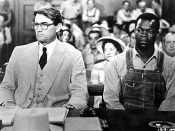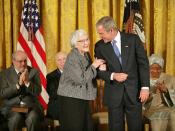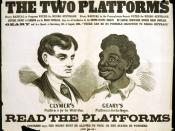"To Kill a Mocking-Bird" has many examples of racism and injustice. During this time in history, racism was acceptable, and injustice was a problem in which everyone faced. Racism and injustice are key themes in Harper Lee's book. Not only were those who were black, but also those who were affiliated with blacks, were considered inferior. An example of injustice is Aunt Alexandra's racist attitudes to blacks as she says, "Jem's growing up now and you are too. We decided that it would be best for you to have some feminine influence." Even though Calpurnia was a female, Aunt Alexandra over-looked this, because of her race.
During the 1930s blacks were of the lowest socio economic group. This was explored comprehensively during Scout's and Jem's trip to Calpurnia's church. We can see that the Negroes of Maycomb highly respected the whites. This is made obvious when Reverend Sykes announces "...We
are particularly glad to have company with us this morning. Mr and Miss Finch." You would not hear that kind of gracious attitude if a Negro arrived to a white church. Another issue was that most Negroes back then could not read or write. During the time at the church, Jem and Scout noticed that there were no hymn books at the church. This is because all, but four Negroes were illiterate. This shows how uneducated the Negroes were back then and how disadvantaged they were. Calpurnia even states: "there wasn't even a school for them when Zeebo was a boy". Unfortunately, they weren't considered equals back then as they were of the lowest socio economic group.
Racism was explored significantly in the case trial. Tom Robinson had so much evidence to prove that he was innocent yet, he was still charged guilty. Why? Because he was black,



Great work.
This really pulls aspects of the whole book together and you don't leave much out. You also make strong points, and convey your argument very well.
0 out of 0 people found this comment useful.